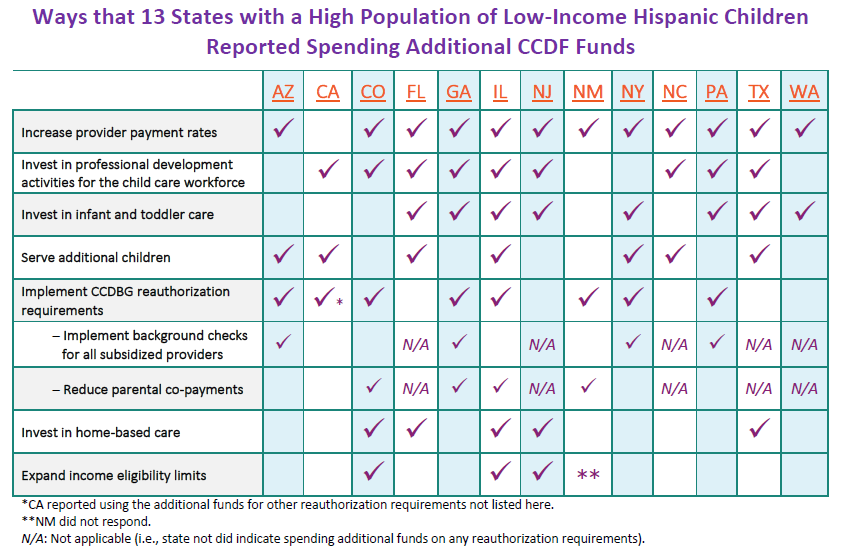How States with Large Hispanic Populations Are Using or Plan to Use Additional Federal Funding for Child Care
Nov 12, 2019
Research Publication
How States with Large Hispanic Populations Are Using or Plan to Use Additional Federal Funding for Child Care
In 2018, Congress appropriated nearly $2.4 billion to help states meet the goals and requirements of the 2014 reauthorization of the Child Care and Development Block Grant (CCDBG), the largest source of federal funding for child care. Here, we look at how 13 states—where 80 percent of the nation’s low-income Hispanic children reside—have spent or are planning to spend this increased federal funding available to states through the Child Care and Development Fund (CCDF).
Nearly all of the Hispanic-populous states we examined have used or plan to use the funds to increase payment rates to providers (12 of 13 states). Likewise, large proportions of Hispanic-populous states have used or plan to use the funds to invest in professional development activities for the child care workforce (9 of 13 states), invest in infant and toddler care (8 of 13 states), and increase the number of children receiving subsidized child care (7 of 13 states). More than half of Hispanic-populous states have used or plan to use the additional funds to implement reauthorization requirements (8 of 13 states); of these, half reported prioritizing reducing parental co-payments, and half reported prioritizing background checks for all subsidized providers (4 of 8 states, respectively).
The majority of Hispanic-populous states have not spent the additional funds to invest in home-based care (only 5 of 13 states have) or to expand income eligibility limits for receiving subsidies (only 3 of 13 states have).

This review draws from a recent Child Trends report examining spending of these funds across all 50 states, the District of Columbia, and U.S. territories and builds on a broader profile of work by Center researchers, including an analysis of state-level CCDF policy and practice through a Hispanic lens. Since financial assistance for child care is administered primarily at the state level, it is important to track state-level CCDGB policies and assess how state policies and practices may differentially shape access to child care for Hispanic families.
Suggested Citation:
Child Trends. (2019). How states with large Hispanic populations are using or plan to use additional federal funding for child care. National Research Center on Hispanic Children & Families. https://doi.org/10.59377/946b8134p
Copyright 2025 by the National Research Center on Hispanic Children & Families.
This website is supported by Grant Number 90PH0032 from the Office of Planning, Research & Evaluation within the Administration for Children and Families, a division of the U.S. Department of Health and Human Services totaling $7.84 million with 99 percentage funded by ACF/HHS and 1 percentage funded by non-government sources. Neither the Administration for Children and Families nor any of its components operate, control, are responsible for, or necessarily endorse this website (including, without limitation, its content, technical infrastructure, and policies, and any services or tools provided). The opinions, findings, conclusions, and recommendations expressed are those of the author(s) and do not necessarily reflect the views of the Administration for Children and Families and the Office of Planning, Research & Evaluation.